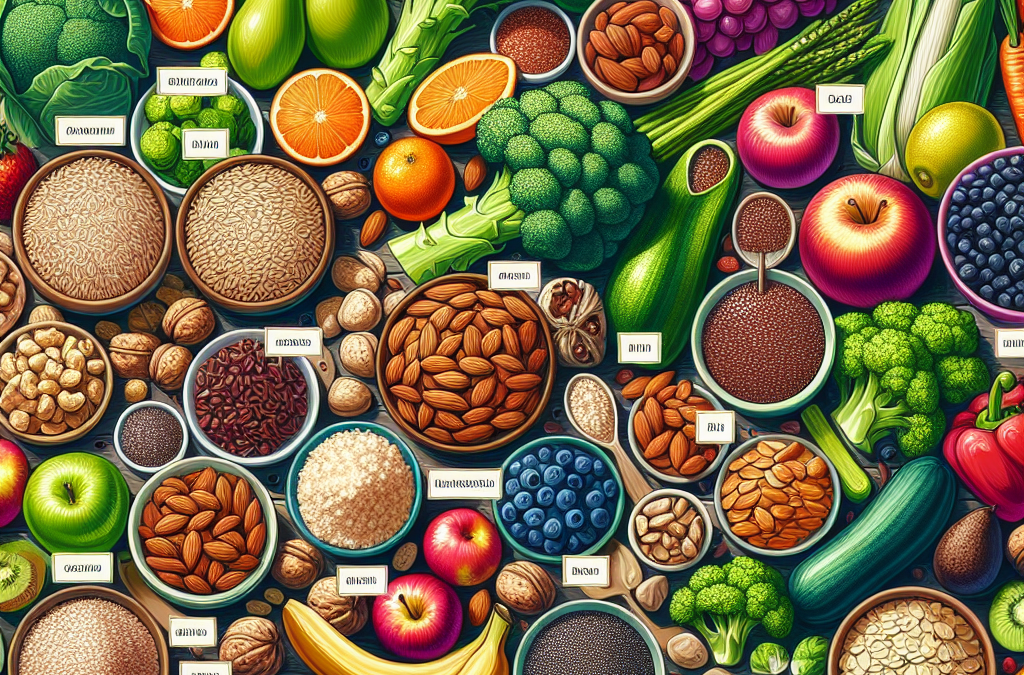Incorporating More Fruits and Vegetables
Variety is Key
When I first started focusing on fiber, I quickly realized that variety is super important. You want to mix it up with different colors and types of fruits and vegetables. Think of it as a rainbow on your plate! Each color often indicates different nutrients, and that’s a win-win for your health.
For instance, dark leafy greens like spinach and kale are fiber powerhouses. Then you’ve got bright orange carrots and sweet potatoes that not only add fiber but also beta-carotene. Even fruits, like apples and berries, provide a delicious way to boost your intake. Plus, they’re easy to snack on!
Packing a variety of produce not only adds fiber to your diet but also makes meals more exciting. I’ve found that when I have a colorful plate, I’m way more inclined to eat my veggies. Get creative and don’t be afraid to experiment with new recipes!
Fresh vs. Frozen
Another thing I learned is that both fresh and frozen fruits and veggies can be nutritious options. Sometimes, fresh produce can spoil quickly if you don’t use it, and that’s just going to waste a ton of potential fiber! Frozen fruits and veggies, on the other hand, are often picked at peak ripeness and flash-frozen to lock in their nutrients.
For my smoothies, I really love using frozen berries as they not only add fiber but also make the drink nice and chilly. They’re super convenient too—just toss a handful in and blend away! In salads, you can roast some frozen vegetables, adding them to your meals without all the prep time.
Understanding that you can enjoy fiber-rich foods in both forms has helped me keep my intake consistent, regardless of the season. So whether you’re hitting the farmer’s market or just stocking up at the grocery store, remember that both options have their place in our diets!
Simple Snack Ideas
Snacking can be a sneaky way to boost fiber without even realizing it. I love to keep some easy options on hand, like carrot sticks with hummus or an apple paired with almond butter. It’s delicious and literally takes seconds to prepare!
Additionally, whole grain crackers with guacamole or yogurt with a sprinkle of granola can be a wonderful snack that adds to daily fiber counts. Sometimes, I make my own trail mix—throw in some nuts, seeds, and a handful of dried fruits (just watch out for added sugars!).
The beauty of these snacks is that they’re not just filling but also provide beneficial fiber while keeping my energy levels up. It’s a fantastic way to curb those mid-afternoon cravings without reaching for something processed!
Choosing Whole Grains
Understanding Whole Grains
Switching from refined grains to whole grains has been one of the best choices I’ve ever made for my diet. Whole grains like brown rice, quinoa, and whole wheat bread provide way more fiber compared to their refined counterparts, which often lack essential nutrients.
When I first made this switch, I began reading labels on everything. It helped me understand what I was actually eating. For example, bread can sometimes look healthy but isn’t the whole grain variety. Go for labels that say ‘100% whole grain’—that’s way better for you!
By keeping whole grains in my diet, not only did I feel fuller for longer, but my digestive health improved too. I noticed such a difference in my energy levels, all thanks to making these simple yet effective changes!
Cooking with Whole Grains
Cooking with whole grains can also be incredibly fun and varied. I’ve found that experimenting with things like quinoa salad or brown rice stir-fries can elevate any meal. You can load up these dishes with plenty of veggies, and the whole grain backdrop is just fabulous for adding fiber.
I always cook a big batch of grains at the start of the week — make them your base and then throw in leftovers or anything fresh and you’ve got yourself a hearty meal. Sometimes, I’ll even use whole grain pasta in my favorite recipes, and trust me, you can’t even really tell the difference in taste!
Plus, there’s an endless supply of recipes online to work from. So, if you’re ever in doubt, dive into a food blog and find that inspiration! Whole grains shouldn’t be boring; they can be deliciously versatile!
Making Small Swaps
Making small swaps is perhaps one of the easiest ways to increase whole grain intake. Instead of white rice, I’ve begun using brown rice or cauliflower rice. Even when I cook up my favorite tacos, I’ll opt for whole grain tortillas instead of standard ones—it’s an instant fiber boost!
Start looking around your kitchen and see where you can replace refined grains. It could be something as simple as using old-fashioned oats for breakfast instead of sugary cereals. I swear, it’s made such a difference in my morning routine, keeping me feeling fuller during those busy mornings!
Even when baking, swapping out white flour for whole wheat flour can add an extra kick of fiber. You might be surprised by how those simple changes have a huge impact on both your fiber intake and overall health.
Snacking on Nuts and Seeds
Understanding the Benefits
I’ve grown to love snacking on nuts and seeds, not just because they’re tasty, but they’re jam-packed with fiber. Almonds, chia seeds, and flaxseeds are just a few examples that can easily be added to meals or enjoyed on their own. They make me feel full and satisfied without going overboard.
Sometimes, I sprinkle seeds on my morning yogurt or blend them into smoothies for that added fiber hashtag. And if you’re wondering, chia seeds expand, making you feel fuller faster—so they’re perfect if you’re looking to cut back on snacking throughout the day!
Don’t underestimate the power of nuts and seeds; they’re also rich in healthy fats, protein, and various nutrients necessary for a balanced diet. Just be cautious with portions, as they can be calorie-dense!
Get an Amazing Discount on the Best Certified Organic Whole Food Supplement!
Easy Recipes with Nuts and Seeds
There are so many cool ways to incorporate nuts and seeds beyond just snacking. I love making energy balls with oats, nut butter, honey, and a couple of tablespoons of chia or flax seeds. They’re a lifesaver when I want something sweet but need a fiber fix.
Another fun recipe I enjoy is homemade granola. Just mix your favorite oats, nuts, seeds, and a touch of honey or maple syrup. Bake it in the oven, and you’ve got a crunchy, fiber-rich breakfast or snack that you can feel good about.
You can also throw them into salads for a nice crunch or top your porridge with them. The options are endless, and you’ll find yourself getting creative with how to include these little powerhouses in your meals.
Portion Control
One thing I’ve learned the hard way is to be mindful of portion control when it comes to nuts and seeds. It’s so easy to get carried away, especially when they’re so tasty! Generally, a handful is all you need to get those health benefits without overdoing the calories.
I often pre-portion them into small snack bags to avoid mindlessly munching while watching TV—a little preparation goes a long way! Plus, it also helps keep things in check, making it easier to track how much I’m eating.
Having a set portion can ensure you’re getting those fiber benefits while staying on track with your overall diet. It’s all about balance, right? So enjoy, but enjoy responsibly!
Staying Hydrated
The Importance of Hydration
Now, let’s chat about hydration. It might seem unrelated, but drinking enough water is super important when increasing your fiber intake. You see, fiber swells in our digestive systems, and without enough water, it can lead to discomfort like bloating or constipation. Blech!
I’ve made it a habit to carry a water bottle with me everywhere I go. Trust me; it’s a great reminder to drink more fluids throughout the day. I’ve tried infusing my water with fruits or herbs like mint for a refreshing twist—it makes staying hydrated way more enjoyable!
Getting decent hydration helps support that fiber’s journey through your digestive tract, making sure it does its job effectively. So, when those extra fiber-rich meals come into play, keep that water flowing!
Signs You’re Dehydrated
Learning the signs of dehydration was also a game changer for me. Things like dry mouth, fatigue, or dark yellow urine can indicate that it’s time to sip up! I try to keep these in mind because nobody wants to feel sluggish, especially when I’m focusing on boosting my nutrition.
On days where I’ve been really busy, I sometimes forget to drink enough water. Having little reminders on my phone or even sticky notes around the house has helped me stay aware. It’s all about creating habits that stick!
If you’re feeling extra sluggish post-fiber load, take a moment to check in with your water intake. You might be surprised how a little extra H2O makes all the difference!
Herbal Teas and Other Hydration Options
Believe me when I say that expanding my hydration options helps a ton! It doesn’t always have to be plain water—herbal teas are a fantastic way to stay hydrated and also enjoy another level of flavor. Plus, some teas can even aid in digestion, complementing your fiber intake perfectly.
I’ve experimented with ginger tea or peppermint tea and found them soothing after meals. Another favorite of mine? Coconut water! It’s hydrating and gives a slight natural sweetness without added sugars.
So whether you’re sipping on tea, pitchin’ a couple of fruits in your water, or partaking in some coconut water, you’ve got plenty of options to stay hydrated while increasing your fiber intake!
FAQ
1. What are the benefits of increasing fiber intake?
Increasing fiber can help with digestion, regulate blood sugar levels, and promote feelings of fullness, which can aid in weight management. It’s also linked to a lower risk of various diseases!
2. How quickly will I see results after increasing fiber?
Many people notice improvements in digestive health rather quickly, sometimes in just a few days. However, it’s important to gradually increase your intake to avoid discomfort.
3. How can I make sure I’m getting enough water with increased fiber?
Carry a water bottle with you, set reminders to drink, and incorporate hydrating foods into your diet, like fruits and vegetables. Aim for at least 8 cups a day—more if you’re consuming a lot of fiber!
4. What counts as whole grains?
Whole grains include foods like brown rice, oatmeal, quinoa, whole wheat bread, and barley. Look for products labeled ‘100% whole grain’ to ensure you are selecting the right options.
5. Can I get enough fiber without eating nuts and seeds?
Absolutely! There are many fiber-rich foods, including fruits, vegetables, whole grains, and legumes. Just mix it up and enjoy a variety to meet your fiber needs!




